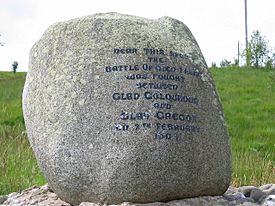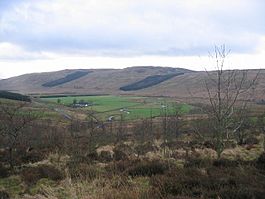Battle of Glen Fruin facts for kids
Quick facts for kids The Battle of Glen Fruin |
|||||||
|---|---|---|---|---|---|---|---|
| Part of the Scottish clan wars | |||||||
 Monument marking the site of the Battle of Glen Fruin |
|||||||
|
|||||||
| Belligerents | |||||||
| Clan Gregor, allied men |
Clan Colquhoun, allied men |
||||||
| Commanders and leaders | |||||||
| Allaster MacGregor of Glenstrae | Sir Alexander Colquhoun of Luss | ||||||
| Strength | |||||||
| 300-400 combined force | 600-800 combined force, including a large proportion of cavalry | ||||||
| Casualties and losses | |||||||
| 2 dead (allegedly) | 140-200 dead | ||||||
The Battle of Glen Fruin was a big fight between two powerful Scottish families, the Clan Gregor and the Clan Colquhoun. It happened on February 7, 1603, in Glen Fruin, which is a valley near Loch Lomond in Scotland. The MacGregors and Colquhouns had been fighting for a long time because the MacGregors often raided the Colquhoun's lands.
The Colquhouns got help from the King and gathered a large army to stop the MacGregors. But during the battle, the MacGregors won a huge victory. After the battle, the King punished the MacGregors very harshly for about 150 years.
Contents
Why the Clans Fought: The Background Story
For many years, the Clan Gregor and Clan Colquhoun had a difficult relationship. The MacGregors were known for raiding, and the Colquhouns often suffered from these attacks.
Archibald Campbell, 7th Earl of Argyll, was given the job of keeping the Clan Gregor under control by King James VI of Scotland. In 1601, the chief of Clan Gregor, Allaster MacGregor of Glenstrae, made a promise to Argyll that his clan would keep the peace. However, instead of stopping the MacGregors, Argyll seemed to encourage them to attack the Colquhouns.
The Colquhouns kept records of everything the MacGregors stole from them, showing how much they suffered.
Trouble at Glenfinlas
In 1602, the MacGregors started making even bigger raids on the Colquhoun lands. Alexander Colquhoun of Luss, the Colquhoun chief, complained to King James VI. The King had made a rule against carrying weapons, but he allowed Colquhoun and his people to carry them for protection. This permission made the MacGregors angry, leading to more conflicts.
One important event happened on December 7, 1602, at Glenfinlas. This is a valley not far from Glen Fruin. A group of about eighty MacGregors, led by Duncan Mackewin MacGregor, raided the Colquhouns. They stole many animals, including cows, horses, sheep, and goats. Two Colquhoun men were killed during this raid.
Some stories say that this raid happened because two MacGregor clansmen were killed by the Colquhouns after they were caught eating a sheep on Colquhoun land. However, historians like William Fraser say that the Colquhouns were the ones who were attacked first.
After the Glenfinlas raid, Colquhoun of Luss went to see the King. He brought female relatives of the people who had been killed or hurt, and they carried the bloody shirts of their loved ones. The King was very upset and promised to get revenge on the MacGregors. He gave Colquhoun of Luss special permission to stop the MacGregor crimes and arrest those responsible. This made the MacGregors gather a large force to fight the Colquhouns.
The Battle of Glen Fruin: What Happened
Allaster MacGregor of Glenstrae led his clan, along with some men from the Clan Cameron, into the Colquhoun lands. They were well-armed with different weapons like hagbuts (early guns), pistols, axes, and two-handed swords.
The MacGregors probably came into Glen Fruin by following a path along Loch Long. To defend his land, Colquhoun gathered his own army. He had permission from the King to raise these men to protect the area and punish the MacGregors.
The two armies met on February 7, 1603, in Glen Fruin. The MacGregors had about 300 to 400 foot soldiers. The Colquhouns had a larger force, estimated at about 300 horsemen and 500 foot soldiers.
The battleground was not good for the Colquhouns, especially for their horsemen. The MacGregors split their forces into two groups. One group was at the top of the valley, and the other was hidden in an ambush near a farm called Strone.
The Colquhouns entered Glen Fruin from the Luss side. Allaster MacGregor quickly moved one of his groups to block the Colquhouns from leaving the valley. At the same time, his brother, John MacGregor, led the ambush group around to the back of the Colquhouns. This meant the Colquhouns couldn't retreat without fighting through the MacGregors. They were not expecting an attack from behind.
Allaster MacGregor and his men bravely charged the Colquhouns. The Colquhouns fought hard for a while. However, because of the difficult ground and the surprise attack from behind, they couldn't hold their position. They ended up in a marshy area near the Auchengaich farm, where their horsemen were useless.
The MacGregors killed many Colquhouns and forced them to retreat. This retreat became even worse when they had to fight through John MacGregor's hidden group. Some accounts say only two MacGregors died, but other historians disagree. The Clan Gregor story says that John MacGregor, the chief's brother, was killed in the battle.
The Colquhoun chief, Alexander Colquhoun, was chased all the way to Rossdhu Castle, where he found safety. Historians say that about 140 Colquhouns were killed in the battle, and many more were wounded. Some sources even say over 200 Colquhouns died.
What Happened After the Battle
After the battle, the government severely punished the Clan Gregor. They were declared "outlaws" for the massacre. King James wanted to bring the Highlands under his control. One of his plans was to try and get rid of the MacGregors.
Their chief, Allaster MacGregor, was executed in 1604, along with eleven of his leaders. Later, in 1633, it even became legal to kill MacGregors and hunt them with bloodhounds. The Clan Gregor was scattered, and many had to change their last names to avoid being hunted.
Years later, King Charles II allowed the MacGregor name to be used again in 1661. But in 1693, King William of Orange disallowed it once more. Finally, in 1784, the MacGregors were allowed to use their own name again and were given back all the rights of British citizens.
In 1609, a man named John Murray arrested Alan Oig Mcan Tuagh in Glen Coe. This man was one of the main people who carried out the killings at the Battle of Glen Fruin. It was said he personally killed forty unarmed people.
Many years later, at the end of the 1700s, the chiefs of Clan Gregor and Clan Colquhoun met at the battle site in Glen Fruin and shook hands, showing that the old feud was finally over.
Stories About Students
There is a story that after the battle, the winning MacGregors killed a group of students who had come to watch the fight. This story says about eighty young men were murdered. However, there are no historical records to prove this happened.
The story is mentioned in the introduction to Walter Scott's novel Rob Roy. It suggests that the killers were from the Clan MacFarlane, who were allies of the MacGregors. One version says that the Colquhoun chief put these students in a barn for safety. But they fell into the hands of the MacGregor chief, who gave them to one of his men, Dugald Ciar Mhor. Dugald supposedly killed them.
However, historians say there is no proof of this event. When the MacGregors were charged with crimes after the battle, this incident was never mentioned. This makes it unlikely that such a big event would have been missed by the authorities.
Music and Poetry About the Battle
The Battle of Glen Fruin has been remembered in art. The poet David Wardlaw Scott wrote about the chiefs of MacGregor and Colquhoun and the battle in his poem Dora Marcelli, The Last of Her Race. The writer Peter McArthur wrote a song called The Raid of Glen Fruin. Another song, The Bloody Sarks, also tells the story of the battle.
Archaeology: Digging Up the Past
In July 1967, archaeologists dug up a mound in Glen Fruin. People thought it might be where the Colquhouns killed in the battle were buried. But the excavation showed that the mound was actually a Bronze Age camp, not a burial site from the battle.
There is also a grey stone in the glen where people believe John MacGregor, the chief's brother, was buried. He was one of the few MacGregors said to have died in the battle.



